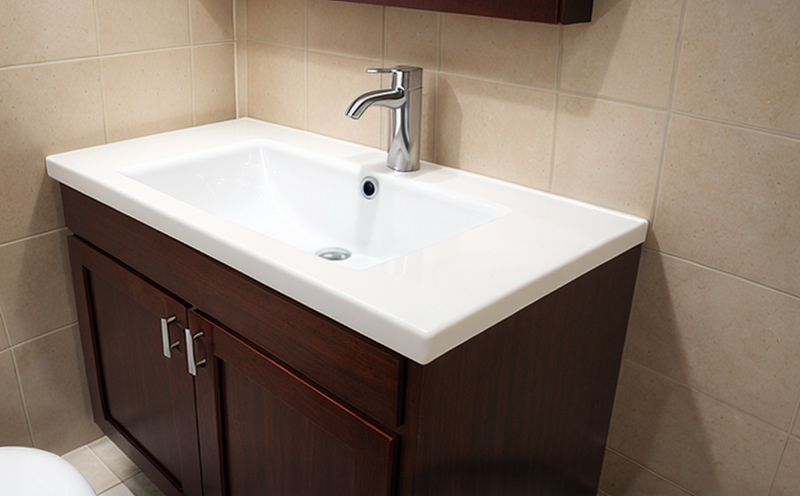NF EN 274-2 Flow Rate Testing of Plastic Sanitary Fittings
The NF EN 274-2 standard is a critical component in ensuring the quality and safety of plastic sanitary fittings used in bathroom applications. This test measures the flow rate through these fittings, which is essential for their proper function and user satisfaction. The standard applies to fittings that are intended for use with water supplies and drainage systems within buildings.
The testing procedure involves filling a fitting with water until it overflows, then measuring the time taken for the water level to drop by 50 mm. This measurement provides an indication of the fitting's flow rate performance, which is crucial for determining its efficiency in real-world applications. The standard specifies that this test should be conducted at room temperature and under specified pressure conditions.
Proper flow rate testing ensures that sanitary fittings meet the requirements set forth by international standards like ISO 15846:2013, which focuses on the performance of plastic pipes for potable water supplies. By adhering to these specifications, manufacturers can guarantee consistent quality and reliability in their products.
This test is particularly important because it affects several aspects of bathroom functionality:
- Water conservation: Efficient flow rates help reduce unnecessary water usage.
- User comfort: Properly flowing fittings enhance the user experience by providing a smooth and reliable supply of water.
- Safety: Ensuring that fittings do not allow excessive water pressure can prevent leaks and potential hazards.
The testing process requires precise measurement tools to ensure accuracy. This includes calibrated stopwatches, measuring cylinders, and other equipment necessary for consistent results. The entire procedure must be conducted under controlled conditions to minimize variables that could affect the outcome.
For quality managers and compliance officers, ensuring adherence to standards like NF EN 274-2 is crucial for maintaining product integrity and avoiding regulatory issues. R&D engineers benefit from this testing as it provides data on how modifications or new designs impact performance. Procurement professionals can leverage these results when selecting suppliers who meet stringent quality criteria.
Understanding the implications of flow rate testing goes beyond mere compliance; it also contributes to broader sustainability goals by promoting efficient use of resources and enhancing product longevity. By implementing robust testing protocols early in the development cycle, manufacturers can identify potential issues before they become costly problems downstream in production or post-sale.
Benefits
Conducting NF EN 274-2 flow rate tests offers numerous advantages for businesses involved with plastic sanitary fittings:
- Quality Assurance: Ensures consistent performance across all products, reducing the risk of defects.
- Regulatory Compliance: Meets stringent international standards to avoid legal challenges and penalties.
- User Satisfaction: Provides reliable fittings that enhance user experience in bathrooms.
- Sustainability: Contributes to water conservation efforts by optimizing flow rates.
- Brand Reputation: Demonstrates commitment to high standards, improving market reputation.
In addition to these direct benefits, regular testing fosters a culture of continuous improvement within the organization. It encourages teams to seek out innovative solutions that not only meet but exceed current expectations set by regulatory bodies and customers alike.
Customer Impact and Satisfaction
The results of NF EN 274-2 flow rate tests significantly impact customer satisfaction and loyalty. Consumers expect products to perform reliably without causing inconvenience or safety concerns. Efficiently flowing sanitary fittings contribute directly to these expectations, creating a positive user experience.
- Reliability: Properly tested fittings are less likely to fail or malfunction, ensuring continuous water supply during critical moments like flushing toilets or running taps.
- Safety: By preventing excessive pressure and potential leaks, these tests enhance the overall safety of bathrooms.
- Eco-friendliness: Efficient flow rates help conserve water resources, aligning with broader environmental goals that resonate well with environmentally conscious consumers.
In practical terms, satisfied customers are more likely to recommend products positively, leading to increased sales and brand loyalty. Furthermore, businesses that invest in thorough testing can differentiate themselves from competitors offering less reliable alternatives, thereby capturing a larger share of the market.
Environmental and Sustainability Contributions
The environmental impact of plastic sanitary fittings is an important consideration given growing concerns about resource depletion and waste management. By optimizing flow rates through rigorous testing, businesses can play a key role in promoting sustainable practices:
- Water Conservation: Efficient flow rate testing directly contributes to reducing water consumption by ensuring that fittings operate optimally.
- Material Efficiency: Ensuring high performance with minimal material usage supports more efficient production processes.
- Reduced Waste: Reliable products mean fewer replacements, which in turn reduces the amount of discarded waste entering landfills.
Incorporating sustainable practices into product development cycles not only benefits the environment but also aligns with consumer preferences. As more consumers prioritize eco-friendly options, businesses that demonstrate a commitment to sustainability will likely see increased customer loyalty and market share growth.





